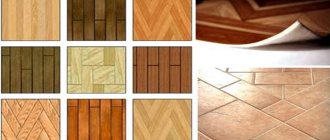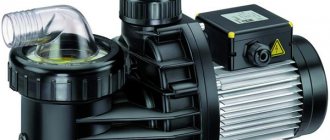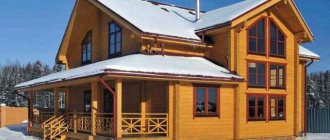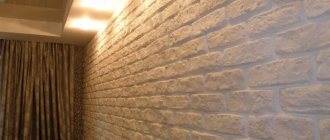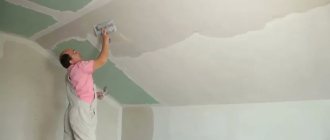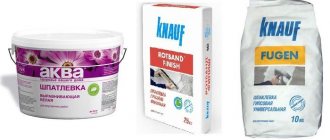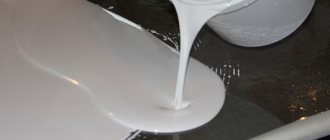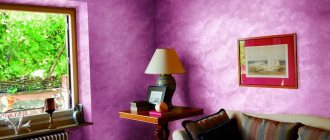Alkyd types of dyes and varnishes are used for application to such substrates as:
- End parquet (the components in the mixtures do not glue the ends together, which makes it possible to eliminate tension).
- Heated parquet flooring.
- "Floating" floors.
- Parquet floors are made from soft wood, with a high level of sensitivity to environmental influences.
The advantages of alkyd compositions are as follows:
- High degree of resistance to sudden changes in temperature and humidity.
- The material absorbs vibrations and is also resistant to other similar loads.
- Alkyd varnishes are not endowed with adhesive properties, which prevents squeaking of painted surfaces.
- Decorative properties. Alkyd compounds saturate porous substrates well, emphasizing their original texture.
- Depending on your wishes, you can choose an alkyd composition with a glossy or matte effect.
- Ease of use. Due to the fact that the consistency of the alkyd product is quite viscous, it covers the surfaces well and evenly (spreads over them).
- They have a high level of resistance to serious mechanical loads (they are difficult to break through). Also not susceptible to chemicals.
- Prevents the formation of mold and fungi and rot.
Along with the advantages, there are also some disadvantages of using:
- The period for complete drying of alkyd varnish compositions is quite long (at least one day). But, if necessary, you can purchase two-component alkyd products (varnish + harden), which dry for a shorter period of time.
- The second drawback is even more unpleasant, as is the persistent smell of alkyd, which does not go away during the entire time the surface dries. The only thing that can help a little is good ventilation of the room.
- If more material was used during painting (that is, the layer turned out to be too thick), the coating may wrinkle. The optimal amount of varnish that must be used for application per 1 m2 is no more than 120 grams.
- Painted surfaces are not very resistant to external influences. Due to this, their service life is reduced (usually no more than 2-3 years).
Yacht alkyd urethane varnish
Parade L20 Yachts & boats glossy
One-component alkyd-urethane varnish.
First of all, I would like to note the exceptional resistance to external influences and good protective properties. It works especially well on wooden surfaces that are used in unfavorable climate conditions. The degree of gloss can vary and can be matte, semi-matte and glossy. GOST allows the use of paint in children's institutions, as well as health care facilities.
White spirit is used as a thinner. Stored in a tightly closed container. The cost of the can is 2850 rubles.
Among other advantages I would like to note:
- resistance to shock, sea water, ultraviolet rays and various temperatures;
- creating a durable coating.
Minuses:
- demanding of accommodation conditions. Do not place near sources of heat and fire;
- assumes storage only in original containers.
Yacht varnish Premia
Eco-friendly acrylic paint. After drying, it forms a durable and reliable layer that can be washed. I recommend using this material to create a cozy design in rooms where heavy traffic is expected. According to the description on the manufacturer's website, it can withstand 50,000 brush passes. Used for medical institutions, sports and children's institutions.
The paint is intended for use on brick, plasterboard, plastered and concrete surfaces. These can be walls covered with putty, as well as wallpaper for painting. It can also be applied to an old layer of water-dispersion paint if you prepare the surface in advance. The cost of a 9 liter bucket of paint is 1000 rubles.
Advantages:
- wide range of colors;
- frost resistance. Can withstand up to 50 cycles of short-term freezing and thawing during transportation;
- hiding power. This quality allows you to use less material and save time required for painting;
- environmental Safety.
Minuses:
not detected.
How to process other materials?
Varnishing, intended to impart a protective layer, is also used on other substrates. For example, cardboard, liquid wallpaper, paper, plastic, metal, etc.
Even old tiles can be updated with this solution. But it must be a special composition; the usual one is not suitable. Such a coating must necessarily contain: a primer; special tile mortar.
First apply a primer. Next, the tiles are coated with the product.
Nail treatment after extensions
The use of biogel for nail extensions is a new service. But this method of improvement has gained popularity among modern women. Biogel helps create an irresistible image, while no negative effects from the indicated composition on the nail plate are noted.
Among the main advantages of biogel is its ability to change the color of nails when a woman wants it. The base will remain stable and intact if there is no acetone in the nail polish remover.
Kinds
Initially, all acrylic varnishes are divided into two large groups: one-component and two-component. One-component varieties contain only acrylic; two-component ones are also characterized by the presence of polyurethane.
It is worth noting that two-component varnishes guarantee higher strength, which is why they are most often chosen for external work.
The most popular are water-based acrylic varnishes. They are increasingly replacing conventional varnishes for coating furniture. Acrylic scuba tanks have become so popular because, compared to other products that are also water-based (alkyd, for example), they are cheaper.
The other side of the coin is strength characteristics. They cannot be called elevated. As a result, such varnishes are not used outdoors.
They are only suitable for painting floors and furniture, but it is important to comply with all requirements regarding working conditions with the paint and varnish material indicated on the packaging. Usually refers to temperature and humidity
Two-component acrylic-polyurethane varieties, despite almost the same price, have higher strength properties than their one-component equivalent. However, you should not use this variety outside the room: it is not suitable for outdoor work.
Acrylate varnishes, also classified as acrylic, have a slightly expanded range of application. So, with their help you can not only tint and give a glossy shine to clean wooden surfaces, but also apply them to already painted elements
It's important to keep one thing in mind here. The paint used for painting must also be water-dispersed, otherwise the varnish will not adhere properly
There are few types of acrylic varnishes, but each of them is universal. If necessary, you can use each of them for exterior decoration, but only under the condition that you live in a temperate climate zone without extreme weather conditions. Otherwise, the paint and varnish material will not withstand and will simply crack, losing the lion’s share of its performance properties.
comparison table
Based on the rating compiled above, we organized the main technical parameters of varnishes and placed them in a table. With this organized information, you can track down the most suitable remedy for yourself.
| Name | Shine | The basis | Weight | Price, rub) |
| EUROTEX | semi-gloss | acrylic | 2.5 | 400 – 850 |
| TEX Pro | glossy | acrylic | 2.5 | 650 – 1 200 |
| VGT | glossy | acrylic | 3 | 350 – 700 |
| Dulux Diamond Glaze | glossy | acrylic-urethane | 0.9 | 480 – 650 |
| Tikkurila | glossy | acrylic | 2.7 | 500 – 680 |
| Parade | glossy | acrylic | 2.6 | 800 – 1 100 |
| Dulux | semi-gloss | alkyd-urethane | 2.5 | 400 – 600 |
This is interesting: How to choose a wear-resistant and moisture-resistant floor varnish - we explain carefully
Advantages and types of water-based varnish products
Any odorless, water-based wood varnish is a solution in which very fine components are evenly distributed. After application, the water immediately begins to dry, resulting in a durable protective film being created on the base. Water-based varnishes that do not have an unpleasant odor have the following advantages:
- are not dangerous for people, so they can be applied even in children's rooms, medical and health institutions;
- do not contain harmful components;
- the coating is of high quality and durable;
- the service life of the surface is significantly extended;
- the treated bases acquire protection from mechanical and chemical influences.
Water-soluble clear varnishes have different binders, so they are divided into two categories:
- single-component. This includes polyurethane and acrylic varnishes;
- two-component. Before application, you need to thoroughly mix both components together. This variety has a higher strength and wear resistance, so a two-component, odorless varnish is often used for floors and other surfaces that are subject to heavy mechanical loads.
What it is?
This composition is a mixture of synthetic resins and natural solvents. The components of the varnish provide it with a high level of adhesion and resistance to moisture.
The quality requirements for alkyd products establish certain standards that the composition must meet - first of all, the varnish must be colorless and form a glossy or matte protective layer on the surface. Some products may have a certain shade. The mixture allows you to increase the aesthetic appeal of the base, emphasizing the depth of color, which is important, for example, for a parquet floor.
As a result of use, the treated surface becomes more attractive. However, the choice of a particular product should be based on personal preferences and the area of use of the surface. Alkyd varnishes differ somewhat in their specificity and chemical content, depending on whether they are used for interior or exterior use.
Alkyd mixtures are widely in demand in comparison with their analogues. This is due to the performance properties of the products, which are several times higher than the existing indicators of oil compositions.
Kinds
There are several types of alkyd varnishes.
Two-pack
They consist of two components, the second component being a desiccant. Before application, the mixture must be combined into one composition in the ratio specified by the manufacturer. After this you can start painting. Typically, a durable and high-quality coating requires surface treatment in 2 or 3 layers.
An important feature of such compositions is the short shelf life of the finished mixture - the solution is suitable for use for 8 hours. According to their characteristics, the compositions are characterized by the highest performance
However, the varnish has a pungent odor, as well as low resistance to sunlight.
Alkyd-urethane
It becomes popular due to the characteristics of the mixture in which alkyds react with polyurethane. The mixture is improved due to a special component - toluene diisocyanate, thanks to which the varnish drying process is carried out slightly differently. First of all, the solvent evaporates, and after that the mixture solidifies when exposed to oxygen. The drying time of the surface with this drying mechanism is reduced, in addition, the resistance to abrasion, temperature influences and high humidity improves.
However, due to the fact that half of the alkyd-urethane varnish consists of an organic solvent, its toxicity increases. The products are also unsafe in terms of fire, so the operation of coatings requires additional safety measures. In addition, if the coating does not dry completely, and the base is already in use, situations are inevitable in which the varnish is deformed, forming serious defects. They can only be removed with a grinder.
Matte and glossy
The compositions differ only in what texture the dried base has after processing. The matte composition forms a more practical surface, since dirt and marks are less visible on it; there are also semi-matte mixtures. Gloss is best used in rooms with minimal lighting, as it reflects light perfectly. In terms of the set of components, both products do not differ at all, which is why the choice of mixture will be based only on the taste preferences of the consumer.
Yacht
Based on the name, the scope of use of the product becomes clear - the mixture is produced for coating wooden yachts, but in addition to treating ships, such a specialized composition can be used on substrates that are used in humid microclimates
However, please note that yacht varnish can only be used for exterior use.
This limitation is explained by the chemical composition of the material - to increase moisture resistance during the production of varnish, toxins, for example, toluene, are included in its main set of required elements.
For metal
In its composition, it is a mixture of alkyds and polymers. The substances provide metal substrates with shine and an attractive appearance. The mixture has high resistance to chemically aggressive substances, high humidity, thermal effects on the surface, in addition, adhesion to various types of material makes it possible to use the varnish indoors and outdoors.
To achieve high quality results, it is better to use products from one manufacturer. Alkyd compositions for parquet can be classified as follows:
- Water-based mixtures. The advantage of the solutions is the absence of odor and environmental friendliness of the product. But such paints and varnishes are expensive.
- Two-component varnishes.
- One-component compositions.
Based on the type of coating, alkyd varnishes are divided into the following subtypes:
- glossy;
- matte;
- semi-gloss;
- semi-matte.
Description
The composition of alkyd varnish includes various synthetic resins, organic solvents and driers. These varnishes have a good adhesion rate and an excellent level of moisture resistance. Nowadays, the use of alkyd varnish is varied; it is used in the following areas:
- for processing end parquet. Since alkyd resins do not allow the ends of parquet dies to stick together, it is alkyd compounds that are used to treat wooden parquet, which prevents the occurrence of surface tension;
- to protect parquet floors where a heated floor system is installed;
- for covering floating floors;
- in order to extend the service life and protect parquet made from rare, delicate types of wood, which are very sensitive to various factors, including temperature and humidity.
Once the alkyd varnish is completely dry, it forms a very durable, hard and transparent protective coating. Some people are hesitant to use alkyd compounds because they think they take a long time to dry. But nowadays, manufacturers have developed special additives that greatly reduce the polymerization time of varnish. Many people are interested in how long does alkyd varnish with drying accelerators take to dry? Final polymerization will take approximately 1-2 days.
When the varnish polymerizes, it produces either a matte or glossy surface, depending on which product was chosen. Wood or metal that is treated with an alkyd solution becomes visually attractive and reliably protected from various negative factors, including chemicals, high humidity, various liquids, etc. Alkyd mixtures are applied very easily and quickly, they have a thick structure, spread well over the surface, while creating a fairly dense coating. One of the effective and popular varnishes is the product of the Kudo company; varnish solutions are produced in the form of aerosols and liquid mixtures.
Methods of varnishing wooden surfaces
Flawless application of varnish on wood is done using special tools. They are selected based on the volume of work to be done and personal preferences.
Roller
Designed for covering smooth surfaces with the material. Using a roller you can quickly cover large areas. Moreover, the varnish will be applied in an even layer. Additionally, you will need to purchase a plastic tray.
The use of a roller is advisable for large areas with a flat surfaceSource baltija.eu
Brush
It is used most often and allows you to treat even hard-to-reach areas. Using a brush, it is easy to apply the material to uneven areas.
Particular attention must be paid to the choice of bristles: it should be of medium length. When treating wood with alkyd varnishes, it is necessary to use fibers of natural origin; for finishing with acrylic compounds, brushes with artificial bristles are more suitable
The quality of the chosen tool will largely determine the outcome of the work.
Experts often recommend choosing a flat brush with a width of about 6 cm
In the process of applying varnish, it is important to ensure that it does not drip from the bristles and that the coating is uniform.. A convenient brush allows you to apply the material even in the most difficult to reach places. Source strourem.ru
A convenient brush allows you to apply the material even in the most difficult to reach places. Source strourem.ru
Spray gun
A professional tool is used when processing large surface areas, allowing you to apply varnish in an even layer, preventing the formation of drips
When using such a mechanism, you must take precautions, be sure to wear protective overalls, a mask and goggles
The use of spray guns guarantees the creation of an even varnish layer and does not allow accidental drips. Source instrumentoria.ru
How long does it take to dry?
Immediately after application, alkyd varnish looks like glue. After about 10 hours, some varnishes that have special hardeners in their composition will already harden. Typically it takes 24 hours for one coat to dry.
It is worth noting that the thickness of the varnish film after drying may become smaller, in this case it all depends on how much of the solvent has evaporated. Its content in alkyd mixtures may vary, and based on this indicator, the toxicity level of the composition increases or decreases.
For more information about alkyd varnish, see below.
Popular posts
- Chair for dressing table Chairs for dressing tables in Moscow - 189 Products Company from Moscow, delivery 29643 a In…
- Silicone sanitary sealant Silicone sanitary sealant white in Moscow - 1491 products Company from Moscow, delivery (tomorrow) 140...
- Shelf in the hallway Currently, there are a huge number of different options for shelves in the hallway, and this is directly ...
- Insulation of the floor in a wooden Insulation of the floor in a wooden house from below: materials and installation technology SHARE ON SOCIAL NETWORKS One of the common…
Yacht varnish for exterior use
Yacht varnish for exterior woodwork is used when processing facade elements, cornices, window frames and other wooden structures used in the open air. Yacht varnish is resistant to the negative effects of salt and fresh water, precipitation and UV rays. Yacht varnish for exterior woodwork is suitable for painting gazebos, benches, wooden fences and structures in direct contact with water (wooden elements of decorative garden bridges and piers).
Yacht varnish for exterior woodwork is produced on the basis of alkyd-urethane resins. The composition often includes antiseptic substances that protect wood from rotting, mold and mildew. For outdoor varnishing, choose a weather-resistant coating that has the hardness of parquet varnish and creates a dirt- and water-repellent film on the surface of the wood. Exterior yacht varnish provides a hard, flexible finish that can be cleaned with household detergents.
| Buy |
Precautionary measures
Storage and transportation of alkyd-urethane compositions must be carried out at a temperature not exceeding 30 degrees above zero. The varnish must be protected from direct sunlight.
When storing, transporting and using varnish, precautions should be taken, since alkyd-urethane compositions contain butanone oxime and cobalt bis. In humans, these substances can lead to an allergic reaction, manifested in dryness and cracking of the skin.
Important! Alkyd-urethane mixtures cannot be disposed of in the sewer system. It is also unacceptable for varnish to enter an unprotected environment.
Specifications
Below are the main standards that an alkyd-urethane-based varnish should have:
- The maximum amount of volatile components is half a kilogram per liter.
- According to ISO 2813, the gloss can be matt or semi-matt.
- The quality of the aclide-urethane product must comply with ISO 9001.
- The maximum wood moisture level is 18%.
- The temperature when coating with alkyd-urethane paintwork materials is 10-25 degrees Celsius, and the humidity can be 40-75%.
- The temperature of the varnish when working with it should be 18-25 degrees Celsius.
- Consumption – liter per 8-12 sq.m.
- Dust drying time is two hours. The coating dries completely in 24 hours (if the humidity is 50%, temperature is 23 degrees Celsius).
- The warranty period is five years.
Varieties
Typically, mixtures containing alkyd resins and polyurethane are used to coat wooden products. There are two types of these solutions:
- alkyd-urethane “yacht” varnish. This composition is used for painting boats and yachts above the waterline;
- parquet composition. It is usually used for the protection and decorative treatment of wooden and parquet floors.
Each of these varieties can be applied to any wood surface. Yacht varnishes are used to protect wooden buildings outdoors. Yacht varnish compositions are usually used to treat verandas, gazebos, terraces, garden buildings, fences, and wood fences. And parquet varnishes are applied to any wooden products during interior work. In addition to the floor, parquet solutions can be applied to staircase railings, window frames, furniture, doors, baseboards, etc.
Both yacht and parquet varnish solutions are available in one-component and two-component versions. Although two-component ones are more expensive, they have better wear resistance and durability. Varnishes can also be classified according to the type of gloss; there are glossy, semi-gloss and matte mixtures. Matte solutions are usually used in very dirty areas and in high traffic areas. The matte layer is easy to clean and shows much less damage. Glossy mixtures strongly reflect light, so they are more often used in rooms with poor lighting or on decorative, elegant products and details.
Manufacturers
The following alkyd-polyurethane varnish products are very popular in our country:
- Parade;
- White house;
- "Boron";
- parquet varnish luxens.
Parade has a high elasticity rate. The protective layer does not crack after many years, and for a long time practically does not wear off. In addition, Parade varnishes highlight the natural grain and texture of wood well. These varnish products are made for use both indoors and outdoors.
White house products have a relatively low cost and almost no perceptible odor. Varnish mixtures from this manufacturer are highly wear-resistant, quickly polymerize and retain the natural shade of wood. White house varnish solutions can be applied both outdoors and indoors.
Russian paints and varnishes "Bor" have good performance properties. The varnishes of this company dry in about 4 hours, after which the protective layer becomes resistant to adverse factors and chemical detergents.
Popular and high-quality parquet varnish luxens is used for external and internal finishing works. It can be applied both to the old varnish layer and to new wood. Parquet varnish solutions are made on a water basis and dry quickly enough, thanks to which repair and finishing work is carried out very quickly. The products have increased strength and wear resistance, have an attractive price, and are manufactured in France.
Popular products
One of the varnishes used by Russian consumers is PF-231, a domestically produced varnish. Despite the simple composition, the coating after applying this alkyd varnish looks neat, and the resulting film has high protective properties. But the service life of this material is short.
More popular is varnish of the MCh-0163 brand, which is not afraid of moisture and mechanical stress. But the film it forms does not have sufficient elasticity, and the material itself is not resistant to ultraviolet radiation. In addition, this type of varnish emits a pungent odor when working with it.
Related article: Features and advantages of using acrylic varnishes
Protective aerosol varnish is resistant to weather conditions. This product is used as a protective varnish on the surfaces of wood, metal, glass, stone, plastic and other materials. This aerosol varnish is easy to apply and quickly spreads over the surface.
Varnish with a one-component composition EP-2146, in which epoxy resin serves as a modifier, has good performance characteristics. This material is used to cover parquet, veneer, fiberboard, chipboard and plywood. Apply in two or three layers, each of which must dry completely before applying the next. The drying time is fully compensated by the long service life of the varnished surface, which becomes extremely durable.
Manufacturers
Several brands are in wide demand among buyers:
- White house
- Parade
- Tikkurila
Alkyd-urethane mixtures from Parade were able to win a large audience, since this manufacturer sells varnishes with increased elasticity. Buyers leave reviews in which they report that the film that forms after applying the product does not crack or deteriorate for a long time. Alkyd products can emphasize the naturalness of wood material and make the floor more impressive. Parade offers its customers mixtures for exterior and interior use.
White house has won over customers with its affordable prices and low scent. The manufacturer produces high-quality varnishes that are characterized by high wear protection, rapid polymerization and a decorative component. Varnish is able to preserve the natural shade of wood. Just like Parade, the manufacturer produces products for working with outdoor and home surfaces.
Tikkurila is considered a trusted manufacturer of many materials for construction work. The brand has won the respect of customers and is known as a manufacturer of reliable and high-quality products. Tikkurila yacht varnish, which is characterized by fast polymerization and excellent spreadability, receives good reviews. The low price helps this brand become a leader among alkyd varnish manufacturers.
We recommend: How to varnish laminate flooring
Patent 2374283
This document contains all the necessary detailed information about paint and varnish products. By studying patent 2374283, you will find out which group the paint and varnish material belongs to, its scope of application, composition, advantages, properties, technical characteristics.
The patent describes in detail what pigments are used to produce different colors. What are the stages of enamel production? Each stage is described in detail. For example, at the first stage it lays down the main components, pigments. After receiving the mass, the second stage begins. Additional components can already be added to it to improve and enhance certain properties.
https://youtube.com/watch?v=-T9O5j5fR4M
Advantages of alkyd-urethane varnish
This parquet varnish has many advantages:
- presentable appearance of the board material;
- drying time does not exceed 6-12 hours;
- wear resistance and high strength of the material;
- easy application to the surface and uniform distribution;
- matte or semi-matte layer formed;
- resistant to moisture and aggressive detergents;
- almost odorless;
- protects the floor well from dirt;
- when the linear dimensions of the coating change, the varnished layer will not crack due to its high elasticity;
- applied without prior priming the surface of the material;
- as a result, the ends of the panels do not stick together;
- non-slip surface;
- highlight the natural color and texture of wood.
Since urethane varnish for hardwood floors has so many benefits, it is worth considering how to apply it to the surface.
Requirements
Clear varnish for wood should:
- form a durable coating and provide a sufficient degree of protection from environmental factors;
- highlight the beauty of wood;
- be environmentally friendly, safe, do not contain toxins and be used in different conditions without harming children and adults;
- have a long service life without the cost of restoration during operation;
- easy to apply and dry quickly.
Transparent varnishes can be:
- single-component;
- two-component (with hardener);
- multicomponent (in addition to the hardener, they include solvents and other additives).
The scope of application is quite extensive. Colorless varnish can not only perform a decorative function, giving things a beautiful appearance with or without shine, but also protect against scratches and significant damage, as well as changes associated with weather conditions or the microclimate in the house. Transparent varnish is used to cover wooden toys, pencils, musical instruments, furniture, floors, walls and even yachts. In the interior of houses, they are used to paint wooden panels for walls or parquet boards for floors, and are also used to cover the external facades of houses, bathhouses and gazebos.
Types of polyurethane paint
Funds are divided into 2 large categories:
- One-component compositions. No mixing of ingredients is required; the enamel is sold ready-made. You can begin application immediately after opening.
- Two-component polyurethane paint. You need to combine the ingredients supplied in separate packages.
According to the composition of the base
The single-component category includes:
- Organic paints. In addition to polyurethane, they contain toluene or xylene. The diluent becomes the appropriate solvent. The paint hardens when the components react with moisture present in the air. The setting time of the layer depends on air humidity.
- Alkyd-urethane enamels. The main ingredient is the varnish of the same name. The paint is characterized by a short drying time, not exceeding 90 minutes. The thinner for this composition is white spirit.
- Water-based products do not have a strong odor. When the paint thickens, you can dilute it with plain water. It is not necessary to use protective equipment during surface treatment. The hard film is formed by contact with moisture in the air.
One-component paint.
Powder paints
This enamel belongs to a separate category. It has the form of a homogeneous mixture, which includes dyes, essential resins, and fillers.
Powder enamel is characterized by high strength. In industrial conditions, it is used to protect structures operated in extreme conditions.
Category of powder paints.
Epoxy-polyurethane coatings
Such products form a durable film that is insensitive to abrasion and aggressive factors. They are used for painting structures operated in aggressive environments. Epoxy-polyurethane compositions are characterized by the best protective properties.
Epoxy-polyurethane coating with good protective properties.
Other two-component formulations
The enamel goes on sale in 2 buckets containing hardener and resin.
The advantages of such funds are:
- Possibility of preparing the required volume of solution. Unmixed paint residues retain their properties during storage.
- The course of the polymerization process without contact with moisture.
- Increased, in comparison with one-component compositions, the strength and wear resistance of the coating.
Two-component products are intended for painting structures that are especially susceptible to aggressive factors.
The components are mixed in a separate container. The paint must be used within 8 hours. The durability of the coating depends on the correct mixing of the ingredients and application technique.
Consumption
The level of consumption of alkyd varnish directly depends on the type of composition used, as well as the professionalism of the craftsman performing the treatment. Manufacturers and experts agree that the composition should be applied in several layers. Usually 2-3 layers are required. It is very important to begin applying the next layer only after the previous one has completely hardened. Based on this, you can understand that the work will take at least 2 days.
The average consumption of alkyd mixtures is 50-70 g/m2. Some types of alkyd varnishes must be diluted before application.
Pros and cons of alkyd-urethane varnish, application
Alkyd-urethane varnish is one of the most popular products on the paint and varnish market.
It is a mixture of urethane components and alkyd resins diluted with an organic solvent.
This product has a wide range of applications in construction and repair work and has excellent performance characteristics.
Advantages of polyurethane compounds
Let's look at the main advantages of varnishes with polyurethane additives. First of all, it is a high drying speed - up to 2 hours.
In addition, alkyd-urethane varnish is environmentally friendly and does not have a strong odor. It has excellent decorative properties: it emphasizes the texture, natural pattern and natural color of wood.
Another significant advantage of the material is that it protects the wooden surface from insects, mold and fungal attack.
Types and scope of application
Traditionally, alkyd-urethane varnish is used to coat wooden surfaces, but the composition can also be used to treat iron, stone, concrete and even glass. The main varieties of the product are yacht and parquet varnishes.
Parquet varnish is used primarily indoors. With its help, you can improve the appearance and increase the wear resistance of various products: furniture, stairs, railings, floors, frames and decorative items.
Thus, glossy products are best used in dark rooms or for small objects, while matte textures are more suitable for discreet interiors and surfaces subject to frequent dirt.
Preparatory activities and application technology
All types of polyurethane varnishes have a similar application technology. It is unacceptable to apply the composition under the influence of direct sunlight and drafts. First you need to clean the surface from grease stains, dirt and dust particles.
After the first layer has dried, it is recommended to apply a second one, perpendicular to the previous one. For highly porous wood species, apply 3 coats.
Alkyd-urethane varnish can be applied at temperatures from + 5...+10 C°. Before starting painting work, you should wear a respirator and gloves. If the composition gets on the skin, you can wash it off with water and soap.
Caring for painted surfaces
If the application technology is followed, its service life reaches from 7 to 10 years, which is good news. Polyurethane varnish coatings reach maximum hardness after 3-4 weeks. It is not recommended to use detergents to care for the painted surface at this time.
Conclusion
Alkyd-urethane varnishes have undeniable advantages. Surfaces treated with this modern product acquire an attractive, noble appearance, increase their service life, and increase their resistance to impacts and various weather conditions.
Also, varnishing prevents wood from rotting and is a reliable barrier to bacteria and insects. No professional training is required to work with it. Polyurethane varnish does not have a strong odor, is environmentally friendly, due to the elasticity of the material it is easily applied to the surface, dries quickly and lasts for many years.
Catalog
Ask a question https://poli-r.ru/article/alkidni-ili-akrilovi-lak
TD Poly-R LLC https://poli-r.ru Shcherbinka urban district, Simferopol highway, building 15/1 Moscow Moscow 142171 Russia +7 TD Poly-R LLC https://poli-r.ru Shcherbinka urban district, Simferopolskoye highway, house 15/1 Moscow Moscow 142171 Russia +7
The difference between alkyd-urethane and acrylic (water-based) varnishes, pros and cons.
Modern industry offers the buyer a choice of two types of coatings for one application, acrylic latex and alkyd resin. When making a choice, the buyer is based primarily on his own experience or on the advice of friends, and since alkyd products appeared on the shelves of our country much earlier, there is much more experience in the use and operation of such coatings, and aqueous solvent products produced in earlier times were not durable. Hence, most people have a stereotype that water-based products are not durable and can easily be washed off during wet cleaning. The purpose of this article is to tell you what the differences are between aqua varnishes and alkyd-urethane-based varnishes, what are the pros and cons of both products.
Compound
The basis of aqua varnishes is not water at all, but acrylic polymer. Plexiglas is a good example of the use of acrylic polymer. The basis of alkyd varnishes is alkyd-urethane resin, which is most often made from a combination of sunflower oil and polyhydric alcohols.
Basic properties
After complete polymerization, acrylic polymer is not afraid of significant temperature changes, exposure to ultraviolet radiation, or prolonged contact with water. Therefore, the acrylic polymer film retains its condition unchanged for a long time, and the color of the wood also remains virtually unchanged. This makes it possible to carry out local repairs of individual areas. And probably the most important plus is that acrylic varnishes use water as a solvent and have virtually no odor, which makes work more comfortable.
The final polymerization of acrylic latex takes from a week to a month (aqua varnish for parquet “POLI-R” gains hardness after 7 days). Until this happens, the surface must be protected from mechanical damage. The components used in the production of acrylic varnishes are more expensive, which affects the final price of the product. Aqua varnishes are a little more difficult to apply and require some skill. It is necessary to carefully smooth the varnish over the surface with a special brush with synthetic bristles, avoiding sagging, drips, and bubbles.
The alkyd resin film is smoother and harder. Alkyd resins polymerize much faster, and the surfaces are ready for use (alkyd parquet varnish “POLI-R” is ready for full use 3 days after applying the finishing layer). Alkyd varnishes are easy to work with; all brush marks are self-leveling, so even non-professionals can get good results.
The main disadvantage is the smell, which each person treats individually, some will find it strong, while others will not pay attention to it (alkyd parquet varnish “POLI-R” is Turkish-made, therefore it uses a solvent purified from essential oils, and accordingly has a weaker odor). Alkyd varnishes always have an amber tint, and accordingly, the color of any wood acquires a yellowish tint, which becomes more saturated under the influence of ultraviolet radiation. Because of this, the previous coating will always be different from the fresh one, so if an area is damaged, the entire coating will have to be redone.
conclusions
So, from the information described above, we can draw the following - acrylic varnishes have much greater advantages in terms of characteristics with regard to the application and operation of coatings, but the acrylic resin itself is weaker in characteristics than alkyd. Therefore, it is necessary to choose a floor varnish that contains a large amount of polyurethane - another type of polymer that has excellent wear-resistant and other useful characteristics, and is not harmful to health.
Therefore, parquet aqua varnish “POLI-R” containing a large amount of polyurethane is suitable not only for floors, but also for doors, children’s and adult furniture, walls, decoupage and much more. It is recommended to use “White House” acrylic varnish to cover surfaces that are not subject to severe physical wear, since they do not contain polyurethane, but these varnishes will easily withstand weather conditions.
Main parameters of acrylic products
These materials are water based. They are used for interior work because they are water-based.
Often used in bedrooms and children's rooms. Apply with a spray gun, roller or brush.
The advantages of this material:
- They have environmentally friendly ingredients because they do not contain organic thinners.
- Fire safety.
- Does not emit toxins, odorless.
- Good strength.
- High level of elasticity.
- Colorless, without a yellow tint, do not change the natural tone of the wood.
- The gloss can be different (glossy, semi-matte or semi-glossy).
Minuses:
- The acrylic composition dries faster than alkyd compositions (in just 24 hours), which is convenient when applying several layers. But to obtain a durable film you need to wait about 10-14 days.
- Such products cannot be used in rooms where there is a lot of traffic.
So, the base may become rough or begin to peel. But, if there is no other way out, then you need to apply a primer layer.
This way you can get a much better quality finish.
Varnishing rules
You can varnish the surface using a spray gun, brush or roller. Applying varnish is allowed at an air temperature of at least 5 degrees. It is necessary to work in a respirator, gloves and goggles to protect the respiratory system, skin and eyes. If the varnish mixture gets on the skin, it should be washed off immediately with warm soapy water. Nearby objects must be protected with cellophane film to prevent splashes of varnish from getting on them, because if they dry out, it will be quite problematic to remove them.
Before applying the composition, it must be mixed thoroughly. If a two-component solution is to be applied, you need to mix both components in the required proportions specified in the instructions. After mixing, the two-component composition must be applied within 3-5 hours, so when treating large areas it is advisable to mix it in small portions.
The process of applying the varnish mixture must be carried out in thin layers so that there are no sagging, drips, and so that the protective layer does not wrinkle. If you are treating floors, you need to start varnishing from the window, moving in the direction of the wood fibers. After the first coat has dried, it is recommended to apply a second coat of varnish in a direction perpendicular to the previous coating.
After the second layer has dried, it is advisable to sand it with fine-grained sandpaper, then apply the third and final layer. If the windows are open in the room, the varnished surface will dry much faster. The varnish layer will become as durable as possible only after a couple of weeks; during this time it is not recommended to walk on it or bring furniture into the room.
Scope of application
In addition to wooden surfaces, other materials can also be treated with a polyurethane mixture.
Let's consider the main area of application of this coating:
- as additional protection for walls, floors and ceilings made of various materials;
- protection of wooden furniture and stairs from chemical and mechanical influences;
- formation of a transparent film on ceramic tiles, as well as impregnation of surfaces made of concrete, brick walls and slate roofing;
- to obtain the effect of a wet stone;
- to protect mineral substrates from corrosion;
- protection and improvement of the aesthetic qualities of parquet flooring;
- to protect stone, metal and concrete bases from rust formation.
How to choose wood varnish
When purchasing, you should pay attention to the following parameters:
- Wear resistance – the highest demands on wear resistance are usually placed on floor coverings. The most popular are polyurethane wood varnishes, which offer optimal protection against abrasion. The same category includes acrylic-urethane and alkyd-urethane paint and varnish compositions.
- Degree of gloss - this parameter will play a significant role in interior design. In every residential room there are objects with the same level of gloss, and therefore the similarity of the varnish with the interior design as a whole should be taken into account.
- Area of use - if interior finishing is required, then you should definitely buy varnish for work inside the house, and if outside, then for exterior work.
- Drying speed – each product will have its own drying time, which will vary from 1/3 hour to several weeks. Water-based compounds dry the fastest, and polyurethane ones take the longest.
- Fire safety - if interior work is carried out in houses made of wood, then it is worth choosing paints and varnishes with excellent resistance to high temperatures. In stores you can find a huge selection of materials that do not support combustion. They are much more expensive than the simplest wood varnishes, but the costs of fire safety still cannot be compared with the expenses that may be needed to restore after a fire.
Next, we propose to consider a separate category of composition.
Dilute, dilute or dissolve
At first glance, there is no difference. Using a special tool, we bring the varnish substance into “working condition”. A solvent is a liquid that dissolves dried varnish, bringing it from a solid to a liquid state. We use a thinner if we need to change (reduce) the viscosity of paints.
Some types of organic eluents perform both roles, but some may be effective in one task and completely useless in another. For example, white spirit can be used to dilute compositions of polyurethane, alkyd and oil groups. But if the varnish has dried, it will not be possible to dissolve it with white spirit.
White spirit can be used to thin some varnishes.
But shellacs, on the contrary, are equally dissolved and diluted with denatured alcohols. But let's not go into such subtle details.
If you need advice on what to thin varnish or what to use for thinning paints, it is better to consult with specialists in this field.
We propose to consider in detail which solvents need to be used in specific cases.

